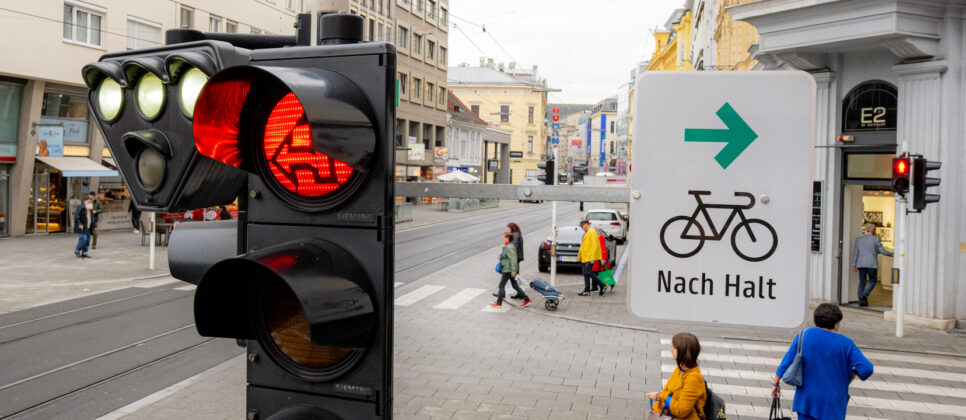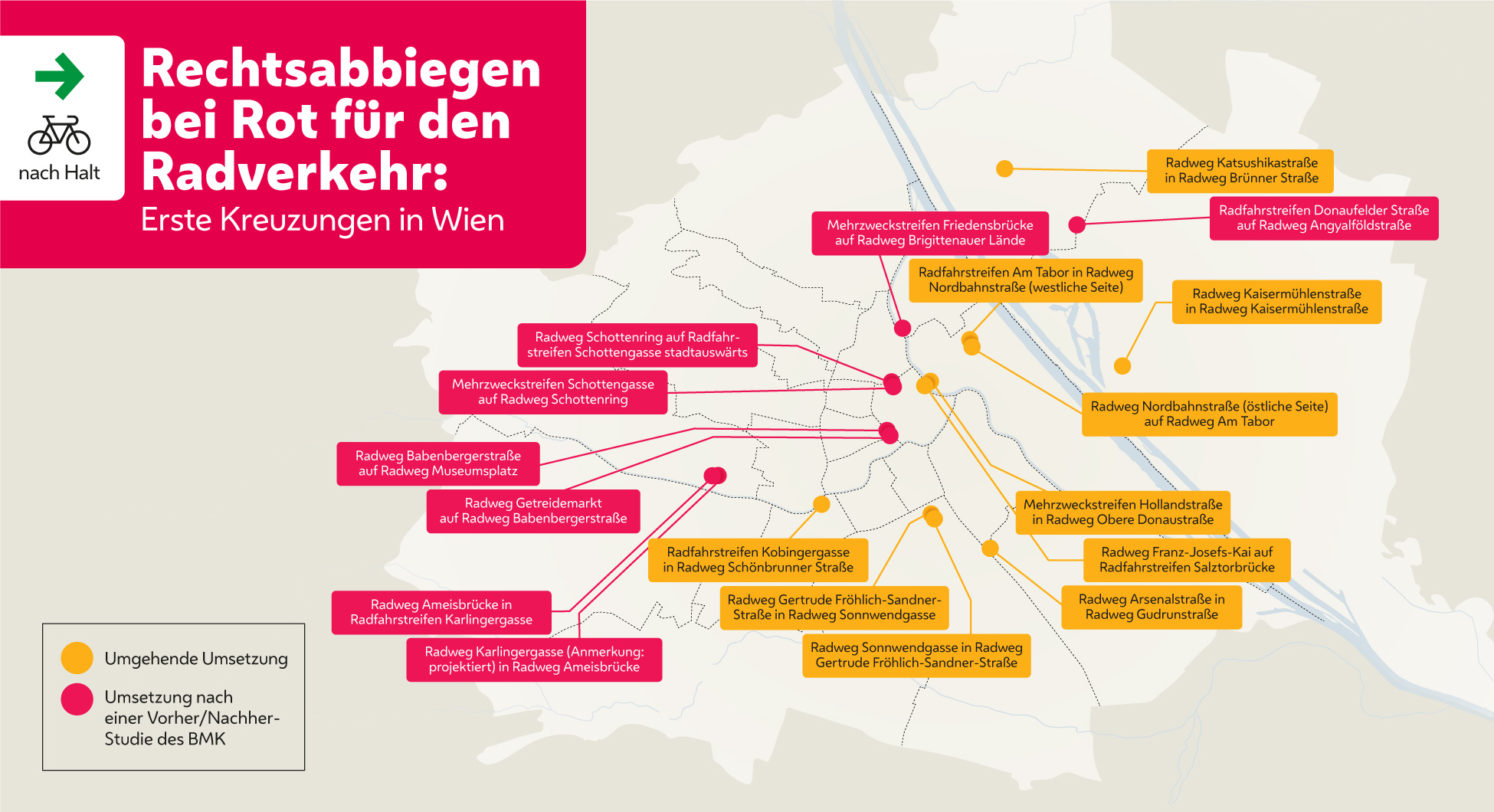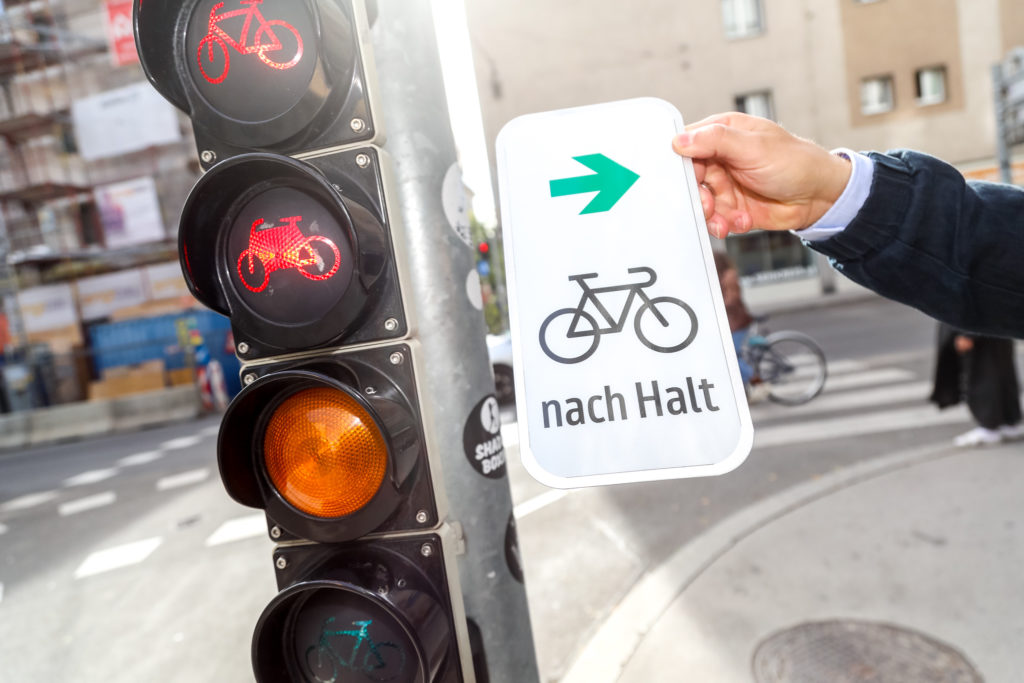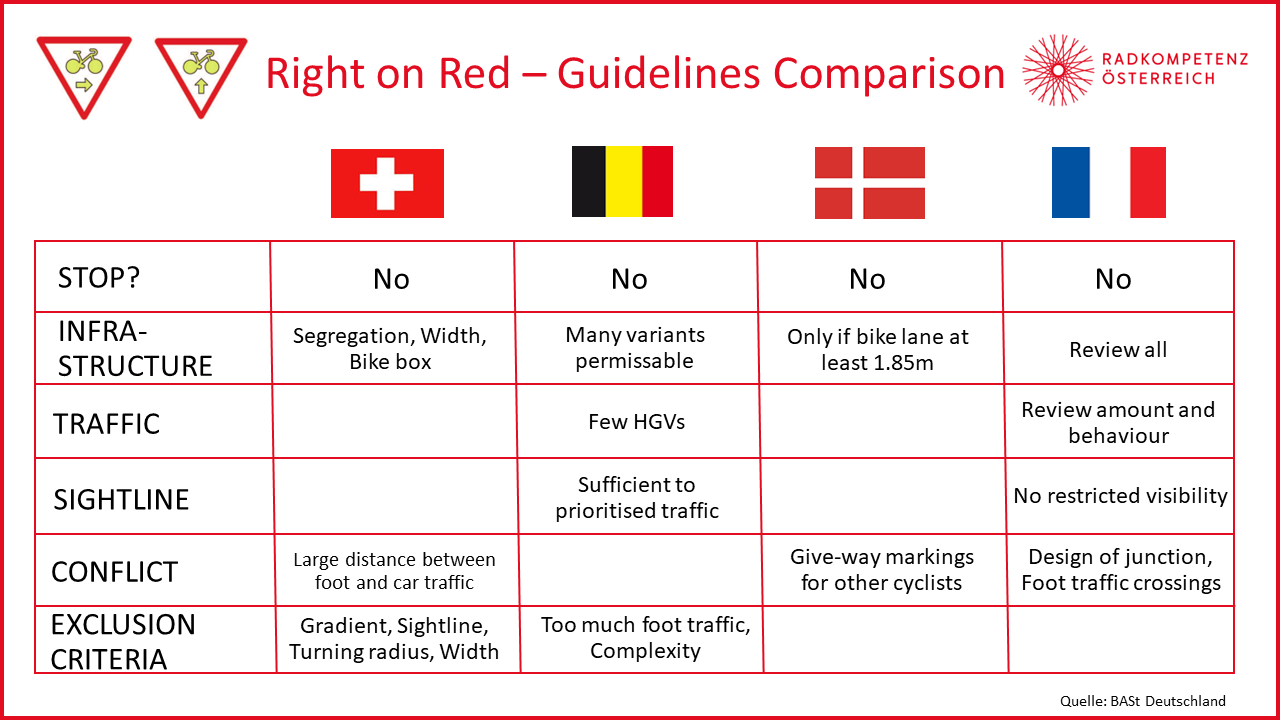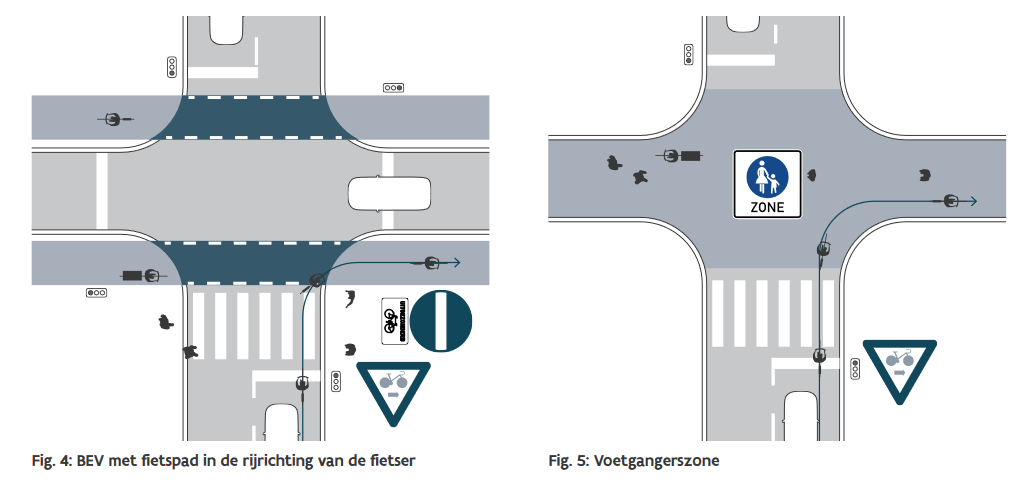‘Right Turn on Red’: First implementation and international guidelines
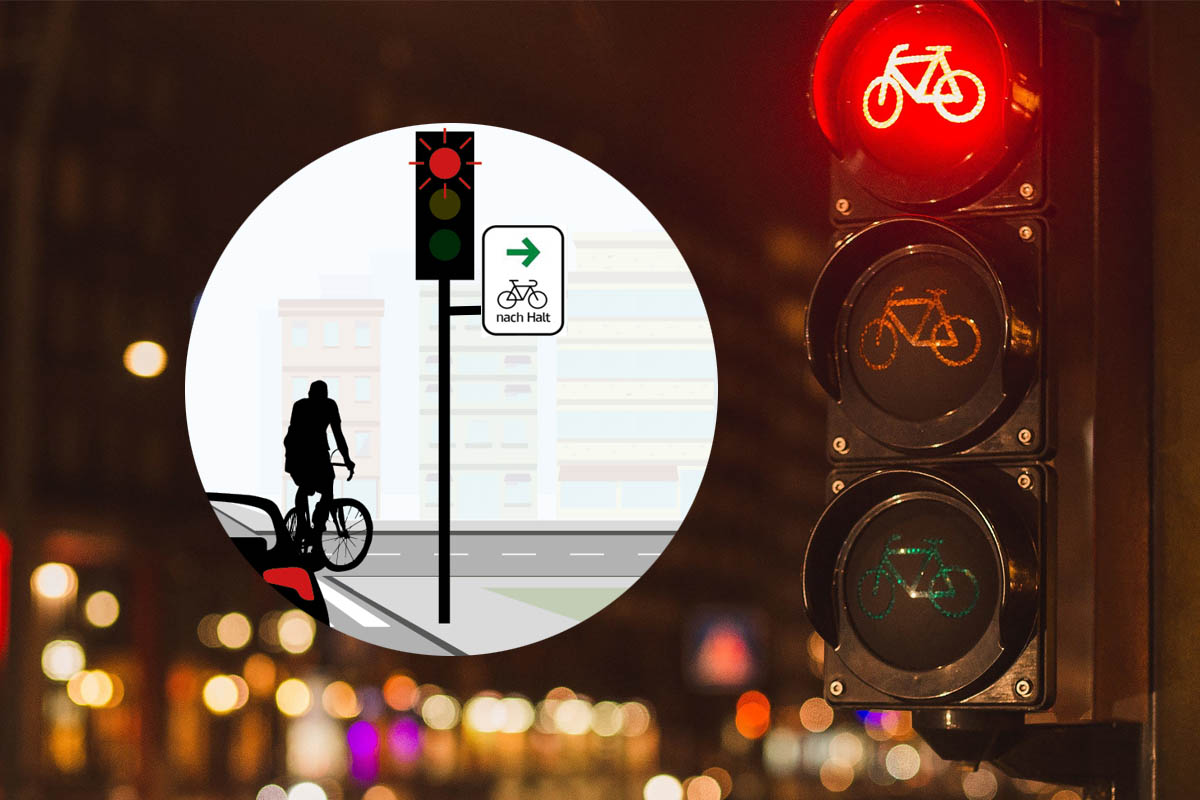
These changes to the Austrian highway code have caused quite a stir: an additional sign with a green arrow now allows cyclists at some junctions to turn right or ride straight on through a red light. The ‘right turn on red’ rule was implemented in countries such as France, Belgium, Denmark, Switzerland and The Netherlands some time ago. Austria is following Germany’s interpretation, using a ‘stop rule’. The Austrian guidelines for the first examples of its implementation are currently developed.
Linz mounts first sign
From 1.10.2022, cyclists in Linz have been able to turn right from the Landstraße into the Bürgerstraße even when the light is red. This is the first of the standardised signs in Austria which allow cyclists to ride through a red light after first coming to a complete stop and then giving way to cross traffic and pedestrians.
According to the Standard and the APA, the vice mayor of Linz Martin Hajart (ÖVP) recently announced that the signs could be introduced to a further 20 junctions. Two of the junctions in question are the Mozartstraße/Fadingerstraße and the Goethestraße/Schubertstraße. The department responsible for this implementation is currently prioritising further junctions for the change.
Announcement of 10 Viennese junctions to be completed in October
The Viennese councillor for traffic, Ulli Sima (SPÖ), has also announced that preparations have started to implement the ‘right on red’ rule at ten junctions in Vienna. By the end of October the appropriate regulations will have been passed and the signage at the junctions implemented. The Ministry for Transport and Climate Protection (BMK) is currently having eight further junctions analysed at which the ‘right on red’ rule may be possible using a before/after study to determine their suitability. The graphic below, by Cycle Competence member Fahrrad Wien shows the junctions in question.
The full list of junctions can be read here.
Which criteria should be used for ‘right turn on red’?
The guidelines are currently being created by a panel from the Research Group Road – Rail – Traffic (FSV – Forschungsgesellschaft Straße – Schiene – Verkehr), led by the Austrian Advisory Board for Transport Safety. The Ministry for Climate Protection and Cycle Competence member Radlobby Austria are also a part of the expert commission as well as representatives from state government agencies.
The City of Vienna has set out a criterium for its ten pilot junctions: the selected junction must have a bike path both approaching and leaving the junction. In the selection of preclusion criteria for the Austrian guidelines, the following issues have been considered:
- Lines of sight
- Cycling infrastructure
- Roads with tram traffic
- School routes
- Heavy traffic volumes, including trucks/HGVs
- Speed limits
- Other modes of transport at the junction
The final guidelines are expected to be published at the beginning of November. They will be published here as soon as they are made public.
Comparison of international ‘right turn on red’ guidelines
Turning right on a red light has already proved itself internationally. The Netherlands have allowed it since 1991, France introduced it in 2015 after a successful three year pilot phase and Switzerland began its pilot tests in 2013 which quickly resulted in its introduction. Belgium and Denmark have also used pilot periods to establish their variants on the rule. In the comparison of four European nations who implemented the law a number of years ago, few barriers can be seen despite thorough safety prerequisites.
This chart of conditions also highlights fundamental differences in the cycling cultures of the respective countries. For example, Denmark insists on segregated cycle paths, due to the fact that they are the prevailing infrastructure. Belgium and France examine every instance before it is implemented, whereas Switzerland specifies minimum widths in mixed traffic and insists on the presence of a ‘bike box’. Lines of sight to the prevailing flow of traffic is a must in all situations and Denmark utilises so-called ‘shark-tooth markings’ (for governing right of way) at potential conflict zones of cyclists. Switzerland strongly recommends large distances between foot and motor traffic.
Only Switzerland has clearly defined conditions under which turning on red cannot be allowed. These include a negative gradient over 4% and a large radius of the corner. Belgium advises against turning on red at complex junctions and in areas with high foot traffic. The Belgian Fietsberaad has compiled an extensive report analysing all possible turning manoeuvres (download here). As a result, they recommend turning right on red in situations such as when riding into a one-way street, or when a cycle path ends in a pedestrian zone where cycling is allowed.
Legal drafting in Austria
Thanks to the 33rd Highway Code amendment, introduced on the 1st of October this year, municipalities and cities now have the power to legally allow turning right, or cycling straight over a red traffic light using the new green arrow sign. Before doing so, cyclists must come to a complete stop, as if at a stop sign and whilst turning, give way to pedestrians crossing the junction. This is very similar to how Germany regulates these junctions and deviates from the four right-of-way models shown above despite all studies showing that it does not increase the risk of an accident. The German Federal Institute for Traffic has also observed that despite the ‘stop’ rule at such junctions rarely being observed by cyclists, safety is maintained and no obviously dangerous situations arise as a result.
This variant can “only be implemented in Austria if the junction chosen causes absolutely no reason to imagine that it could present a danger to road safety for its users.”
All the details of the new highway code (StVO) changes have been summarised here.
_ _ _ _ _
Source for international guideline comparison: Bundesanstalt für Straßenwesen – Niestegge, M., Schüller, H., Hantschel, S., Schröter, B., Gerike, R. (2022), Pilotversuch des Rechtsabbiegens von Rad Fahrenden bei Rot, Berichte der Bundesanstalt für Straßenwesen, Verkehrstechnik, Heft V 355, Bergisch Gladbach: download hier
Fotos: APA/fotokerschi.at, PID Wien
Cycling Competence Members in this article:
More articles with this member:
Share this article:
‘Right Turn on Red’: First implementation and international guidelines
Share this article:

These changes to the Austrian highway code have caused quite a stir: an additional sign with a green arrow now allows cyclists at some junctions to turn right or ride straight on through a red light. The ‘right turn on red’ rule was implemented in countries such as France, Belgium, Denmark, Switzerland and The Netherlands some time ago. Austria is following Germany’s interpretation, using a ‘stop rule’. The Austrian guidelines for the first examples of its implementation are currently developed.
Linz mounts first sign
From 1.10.2022, cyclists in Linz have been able to turn right from the Landstraße into the Bürgerstraße even when the light is red. This is the first of the standardised signs in Austria which allow cyclists to ride through a red light after first coming to a complete stop and then giving way to cross traffic and pedestrians.
According to the Standard and the APA, the vice mayor of Linz Martin Hajart (ÖVP) recently announced that the signs could be introduced to a further 20 junctions. Two of the junctions in question are the Mozartstraße/Fadingerstraße and the Goethestraße/Schubertstraße. The department responsible for this implementation is currently prioritising further junctions for the change.
Announcement of 10 Viennese junctions to be completed in October
The Viennese councillor for traffic, Ulli Sima (SPÖ), has also announced that preparations have started to implement the ‘right on red’ rule at ten junctions in Vienna. By the end of October the appropriate regulations will have been passed and the signage at the junctions implemented. The Ministry for Transport and Climate Protection (BMK) is currently having eight further junctions analysed at which the ‘right on red’ rule may be possible using a before/after study to determine their suitability. The graphic below, by Cycle Competence member Fahrrad Wien shows the junctions in question.
The full list of junctions can be read here.
Which criteria should be used for ‘right turn on red’?
The guidelines are currently being created by a panel from the Research Group Road – Rail – Traffic (FSV – Forschungsgesellschaft Straße – Schiene – Verkehr), led by the Austrian Advisory Board for Transport Safety. The Ministry for Climate Protection and Cycle Competence member Radlobby Austria are also a part of the expert commission as well as representatives from state government agencies.
The City of Vienna has set out a criterium for its ten pilot junctions: the selected junction must have a bike path both approaching and leaving the junction. In the selection of preclusion criteria for the Austrian guidelines, the following issues have been considered:
- Lines of sight
- Cycling infrastructure
- Roads with tram traffic
- School routes
- Heavy traffic volumes, including trucks/HGVs
- Speed limits
- Other modes of transport at the junction
The final guidelines are expected to be published at the beginning of November. They will be published here as soon as they are made public.
Comparison of international ‘right turn on red’ guidelines
Turning right on a red light has already proved itself internationally. The Netherlands have allowed it since 1991, France introduced it in 2015 after a successful three year pilot phase and Switzerland began its pilot tests in 2013 which quickly resulted in its introduction. Belgium and Denmark have also used pilot periods to establish their variants on the rule. In the comparison of four European nations who implemented the law a number of years ago, few barriers can be seen despite thorough safety prerequisites.
This chart of conditions also highlights fundamental differences in the cycling cultures of the respective countries. For example, Denmark insists on segregated cycle paths, due to the fact that they are the prevailing infrastructure. Belgium and France examine every instance before it is implemented, whereas Switzerland specifies minimum widths in mixed traffic and insists on the presence of a ‘bike box’. Lines of sight to the prevailing flow of traffic is a must in all situations and Denmark utilises so-called ‘shark-tooth markings’ (for governing right of way) at potential conflict zones of cyclists. Switzerland strongly recommends large distances between foot and motor traffic.
Only Switzerland has clearly defined conditions under which turning on red cannot be allowed. These include a negative gradient over 4% and a large radius of the corner. Belgium advises against turning on red at complex junctions and in areas with high foot traffic. The Belgian Fietsberaad has compiled an extensive report analysing all possible turning manoeuvres (download here). As a result, they recommend turning right on red in situations such as when riding into a one-way street, or when a cycle path ends in a pedestrian zone where cycling is allowed.
Legal drafting in Austria
Thanks to the 33rd Highway Code amendment, introduced on the 1st of October this year, municipalities and cities now have the power to legally allow turning right, or cycling straight over a red traffic light using the new green arrow sign. Before doing so, cyclists must come to a complete stop, as if at a stop sign and whilst turning, give way to pedestrians crossing the junction. This is very similar to how Germany regulates these junctions and deviates from the four right-of-way models shown above despite all studies showing that it does not increase the risk of an accident. The German Federal Institute for Traffic has also observed that despite the ‘stop’ rule at such junctions rarely being observed by cyclists, safety is maintained and no obviously dangerous situations arise as a result.
This variant can “only be implemented in Austria if the junction chosen causes absolutely no reason to imagine that it could present a danger to road safety for its users.”
All the details of the new highway code (StVO) changes have been summarised here.
_ _ _ _ _
Source for international guideline comparison: Bundesanstalt für Straßenwesen – Niestegge, M., Schüller, H., Hantschel, S., Schröter, B., Gerike, R. (2022), Pilotversuch des Rechtsabbiegens von Rad Fahrenden bei Rot, Berichte der Bundesanstalt für Straßenwesen, Verkehrstechnik, Heft V 355, Bergisch Gladbach: download hier
Fotos: APA/fotokerschi.at, PID Wien

